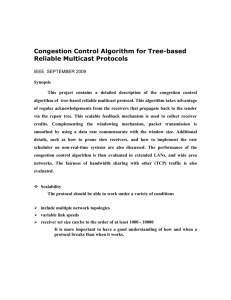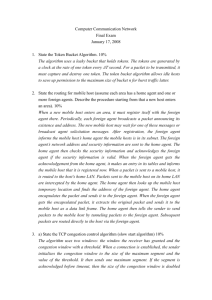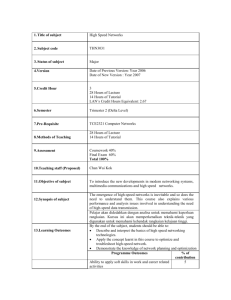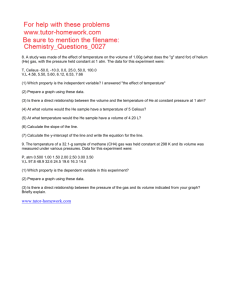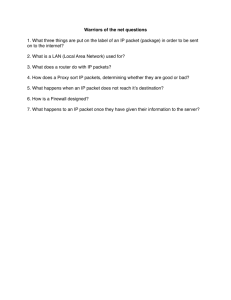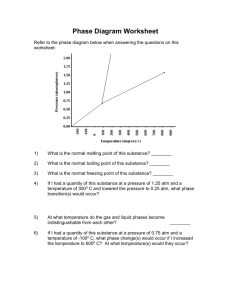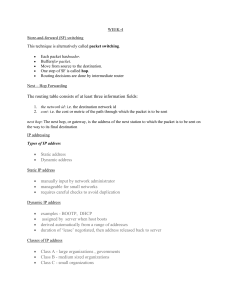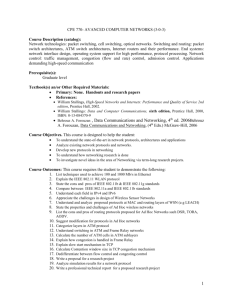UNIT-I - vi institute of technology
advertisement
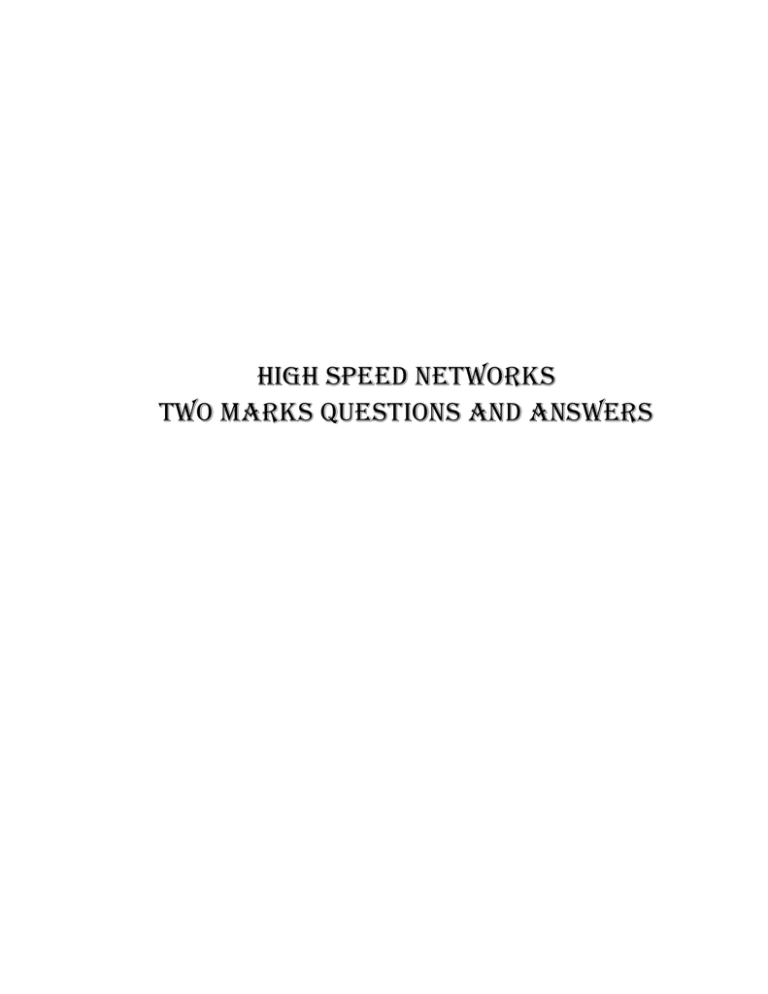
HIGH SPEED NETWORKS TWO MARKS QUESTIONS AND ANSWERS UNIT-I 1. Define frame relay. A form of packet switching based on the use of variable-length link-layer frames. There is no network layer, and many of the basic functions have been streamlined or eliminated to provide for greater throughput. 2. Define ATM. Asynchronous Transfer Mode (ATM) is a method for multiplexing and Switching that supports a broad range of services. ATM is a connection-oriented packet switching technique that generalizes the notion of a virtual connection to one that Provides quality-of-service guarantees. (Or) A form of packet transmission using fixed size packets, called cells. ATM is the data transfer interfaces for B-ISDN. Unlike X.25, ATM does not provide error control and flow control mechanisms. 3. Define ATM adaptation layer (AAL) The layer that maps information transfer protocols onto ATM. 4. Name two WAN technologies. a) Frame relay. b) ATM 5. Write down the advantages of packet switching. a) Flexibility b) Resource sharing c) Robustness d) Responsiveness 6. Define jitter A phenomenon in real- time traffic caused by gaps between consecutive packets at the receiver. 7. How circuit switching networks began to be used increasingly for data connections? a). In a typical terminal-to-host data connection, much of the time the line is idle. Thus, with data connections, a circuit-switching approach is inefficient. b). In a circuit-switching network, the connection provides for transmission at a constant data rate. Thus each of the two devices that are connected must transmit and receive at the same data rate as the other. This limits the utility of the network in interconnecting a variety of host computers and terminals. 8. Write down the advantages of packet switching network over circuit switching. a). Line efficiency is greater, because a single node-to-node link can be dynamically shared by many packets over time. b). A packet-switching network can carry out data-rate conversion. c). Priorities can be used. 2 9. What are the main features of ATM? 1. The service is connection-oriented, with data transfer over a virtual circuit. 2. The data is transferred in 53 byte packets called cells. 3. Cells from different VCs that occupy the same channel or link are statistically multiplexed. 4. ATM switches may treat the cell streams in different VC connections unequally over the same channel in order to provide different qualities of services (QOS). 10. What are the traffic parameters of connection-oriented services? 1. Peak Cell Rate (PCR) 2. Sustained Cell Rate (SCR) 3. Initial Cell Rate (ICR) 4. Cell Delay Variation Tolerance (CDVT) 5. Burst Tolerance (BT) 6. Minimum Cell Rate (MCR) 11. What are the quality service (QoS) parameters of connection-oriented services? 1. Cell Loss Ratio (CLR) 2. Cell Delay Variation (CDV) 3. Peak-to-Peak Cell Delay Variation (Peak-to-Peak CDV) 4. Maximum Cell Transfer Delay (Max CTD) 5. Mean Cell Transfer Delay (Mean CTD) 12. Types of delays encountered by cells 1. Packetization delay (PD) at the source 2. Transmission and propagation delay (TD) 3. Queuing delay (QD) at each switch 4. Affixed processing delay (FD) at each switch 5. A jitter compression or depacketization delay (DD) at the destination. 13. What do you mean by ATM addressing? An ATM address indicates the location of an ATM interface in the network topology. This means that ATM address is not portable. The prefix of an address is associated with a group of interfaces with the same prefix. 14. Types of ATM network interface. Two most important interfaces are: 1. User-network interface (UNI) 2. Network-network interface or network-node interface (NNI). 15. What do you mean by user-network interface (UNI) and network-network interface or Network-node interface (NNI)? UNI is the interface between an ATM end system and an ATM switch, NNI is the interface between two ATM switches. 16. What are the two sub layers of AAL? 1. Convergence Sub layer (CS) 2. Segmentation and Reassembly Sub layer (SAR). 3 17. What is the function of CS? The Convergence Sublayer (CS) converts the information stream into four types of packets streams, called AAL Type1, Type2, Type3/4, and Type5.The packet formats match the requirements of the information stream. 18. What are the subdivisions of CS? 1. Upper, service-specific or SSCS sub layer 2. Lower, common part or CPCS sub layer. 19. What do you mean by Type1 traffic? Type1 traffic is a traffic generated at constant bit rate, and it is required to be delivered at the same rate (with a fixed delay). 20. What is meant by traffic policing? In management and control the network must monitor the data transfer to make sure that the source also conforms to the QoS specification and to drop its cells as appropriate, is said to be a traffic policing. 21. What are the functions of management and control? 1. Fault management 2. Traffic and congestion control 3. Network status monitoring and configuration 4. User/network signaling. 22. What are the layers of BISDN reference model? User plane, Control plane, Layer management plane, Plane management plane. 23. What are the basic tasks required for internetworking over ATM? Two basic tasks are: 1. Encapsulation of the protocol data unit 2. Routing of bridging of PDU. 24. What are the functions of user plane? It compromise the functions required for the transmission of user information for instance, for an internet protocol over ATM, these layers could be HTTP/TCP/IP/AAL5. 25. What are the three strategies of IP over ATM? The three strategies are 1. The classical IP model 2. The short cut models 3. The integrated models. 4 26. What are the basic signaling function between the network and user? The basic signaling function between the network and user are as follows: 1. The user requests a switched virtual connection 2. The network indicates whether the request is accepted or not 3. The network indicates error conditions with a connection. 27. What are the two basic tasks required for internetworking over ATM? The first is encapsulation of the protocol data units, and the second is Routing or Bridging of these PDUs. 28. Define fast Ethernet Fast Ethernet refers to a set of specifications developed by the IEEE 802.3 committee to provide a low-cost, Ethernet-compatible LAN operating at 100 Mbps. 29. Tabulate some characteristics of high speed networks? Wireless LAN Fast Ethernet Gigabit Ethernet Fibre channel Data rate 100 Mbps 1 Gbps,10 Gbps 100 Mbps-3.2 Gbps 1 Mbps – 54 Mbps Transmission media UTP,STP, optical fiber UTP, shield cable, optical fiber Optical fiber, coaxial cable, STP 2.4 GHz, 5-GHz microwave Access method CSMA/CD CSMA/CD Switched CSMA/polling Supporting standard IEEE 802.3 IEEE 802.3 Fibre channel association IEEE 802.11 30. Define gigabit Ethernet? Gigabit Ethernet, which has a data rate of 1000 Mbps (Or) 1 Gbps. In which collision domain is reduced. Gigabit Ethernet is mainly designed to use optical fiber, although the protocol does not eliminate the use of twisted pair cables. There are four implementations have been designed for gigabit Ethernet: a) 1000Base-LX b) 1000Base-SX c) 1000Base-CX d) 1000Base-T 31.List requirements for WLAN? a). Throughput b). Number of nodes c). Connection to backbone LAN d). Service area e). Battery power consumption f). Transmission robustness and security 5 g). Collocated network operation h). License-free operation i). Handoff/roaming j). Dynamic configuration 32. List out the important services of IEEE 802.11? a) Association b) Reassociation c) Disassociation d) Authentication e) Privacy 33. Mention the requirements for fibre channels? a) Full duplex links with two fibers per link. b) Performance from 100 Mbps TO 800 Mbps on a single line. c) Small connectors d) Support for distances up to 10 km. e) High capacity utilization with distance insensitivity. f) Broad availability. g) Small systems h) Interface and network protocols. 34. List out the fibre channel elements? a) Node: The key elements of a fibre channel network are the end systems. b) Fabric: The collection of switching elements 35.What is the datalink control functions provided by LAPF? LAPF core provides a minimal set of datalink control functions consisting of the following (i)Frame delimiting, alignment & transparency. (ii)Frame multiplexing/demultiplexing using the address field. (iii)Inspection of the frame to ensure that it consist of an integer no. of octets prior to zero bit insertion or following zero bit extraction. (iv)Inspection of the frame to ensure that it is neither too long nor too short. (v)Detection of transmission errors. (vi)Congestion control functions. 36. What are the main functions of ATM? ATM uses fixed size cells consisting of a 5-octet header & a 48-octet information field. There are several advantage to the use of small, fixed size cells. (i)First the use of small cells may reduce queuing delay for a high priority cell becoz it waits less if it arrives slightly behind a lower-priority cell that gained access to a resource. (ii)Second it appears that fixed size cells be switched more efficiently which is important for the very high data rates of ATM. (iii)With fixed size cells it is easier to important the switching mechanism in hardware. 37. What is virtual path & connection identifier? The Virtual Path Identifier (VPI) constitutes a routing field for the network. It is 8 bits at the user-network interface & 12 bits at the network-network interface. The latter allows support for an expanded number of VPC’s internal to the network to include those supporting subscribers & those required for network management.The VCI is used for routing to & from the end user. 6 38. What is ATM? Asynchronous transfer mode (ATM) also known as cell relay. It is similar in concept to frame relay. Both frame relay & ATM take advantage of reliability & fidelity of modern digital facilities to provide faster packet switching than X.25. ATM is even more streamlined than frame relay in its functionality & can support data rates several orders of magnitudes greater than frame relay. 39. list the levels of fiber channel & the function of each level? FC-0 PHSICAL MODE Includes optical fiber for long distance application, co-axial for high speeds over short distances & shielded twisted pair for lower speeds over short distance. FC-1 TRANSMISSION POROTOCOL Defines the signal encoding scheme. FC-2 FRAMING PROTOCOL Deals with defining topologies, frame format, flow & error control & grouping of frames into logical entities called sequences & exchanges. FC-3 COMMON SERVICES Include multicasting. FC-4 MAPPING Defines the mapping of various channel & network protocol to fiber channel, including IEEE 802, ATM, IP & the Small Computer System Interface (SCSI). 40. What is meant by SAR & CS? The AAL layer is organized in two logical sub layers: SAR & CS SAR: Segmentation And Reassembly sub layer is responsible for packing information at the other end. CS: The Convergence Sublayer provides the function needed to support specific application using AAL. 41. Difference b/w AAL ¾ & AAL 3/5 AAL 3/4 AAL 3/5 (i)In this MID field is used to multiplex diff streams of data on the same virtual ATM connection. (ii)A 10 bit CRC is provided for each SAR PDU. (iii)In this 8 octets per AAL SDU, 4 octets per ATM cell. (i)In this MID field is assumed to that the higher layer software takes care of such multiplexing. (ii)A 32 bit CRC protects the entire cpu’s PDU, provides strong protection against bit errors. (iii)8 octets per AAL SDU, 0 octets per ATM cell. 42. Give the data rates for frame relay & X.25? The lower bit rate for X.25 is 64 kbps. The fixed data for frame relay is 1.544mbps. The higher data rate for frame relay is 44.376mbps. 43. Define Ethernet. As packet switching has dominated wide area data networking, Ethernet dominates local area networking. The original experimental Ethernet operated at 3mbps over coaxial cable. This remarkable over twisted pair & optical fiber as well as coaxial cable. It was released commercially at 10 mbps & then was scaled up first to 100bps & none 1 & 10 gbps 7 UNIT-II PROTOCOLS AND STRUCTURES 1. When queue will be formed in a network Queue will be formed, if the current demand for a particular service exceeds the Capacity of service provider. 2. What are the characteristics of queuing process/ Characteristics of queuing process depend on: a) Arrival pattern b) Service pattern c) Number of server d) Queue discipline e) System capacity f) Number of channels 3. What is meant by traffic intensity in queuing analysis? And write littles formula for single server queue? Traffic intensity (or) utilization factor ρ = λ/μ = arrival rate / rate service Little’s formula ρ = λ TS r = λ Tr w = λ Tw 4. Compare Single Server and Multi Server Queue. S.No 1 2 Single server model Congestion statistics for this model are:M/M/1, M/D/1, M/G/1 Arrival rate = λ Multiserver model Congestion statistics for this model is M/M/N. Arrival rate for each server = λ/N 5. What is meant by implicit congestion signaling? When network congestion occurs, packets get discard and acknowledgement will be delayed. As a result, sources understand that there is congestion implicitly. Here, users are notified about congestion indirectly. 6. What is meant by explicit congestion signaling? In this method, congestion is indicated directly by a notification. The notification may be in backward or forward direction. 7. Define committed burst size (BC) It is defined as the maximum number of bits in a predefined period of time that the network is committed to transfer with out discarding any frames. 8. Define committed information rate (CIR) CIR is a rate in bps that a network agrees to support for a particular frame mode connection. Any data transmitted in excess of CIR is vulnerable to discard in event of congestion. CIR < Access rate 8 9. Define excess burst size (Be) It is defined as the maximum number of bits in excess of BC that a user can send during a predefined period of time. The network is committed to transfer these bits if there is no congestion. Frames with Be have lower probability to transfer than frames with BC. 10. Define access rate. For every connection in frame relay network, an access rate (bps) is defined. The access rate actually depends on bandwidth of channel connecting user to network. 12. Write Little’s formula. Little’s formula is defined as the product of item arrive at a rate of λ, and Served time of items Tr (or) product of item arrive at a rate of λ and waiting time of an items Tw. It is given as, r = λ Tr (or) w = λ Tw 14. List out the model characteristics of queuing models. a) Item population. b) Queue size c) Dispatching discipline 15. List out the fundamental task of a queuing analysis. Queuing analysis as the following as a input information. a) Arrival rate b) Service rate c) Number of servers Provide as output information concerning: a) Items waiting b) Waiting time c) Items queued d) Residence time 16. State Kendall’s notation. Kendall’s notation is X/Y/N, where X refers to the distribution of the interarrival times, Y refers to the distribution of service times, and N refers to the number of servers. The most common distributions are denoted as follows: G = General distribution of interarrival times or service times GI = General distribution of interarrival times with the restriction that Interarrival times are independent. M = Negative exponential distribution D = Deterministic arrivals or fixed-length service. Thus, M/M/1 refers to a single-server queuing model with poisson arrivals (Exponential interarrival times) and exponential service times. 17. List out the assumptions for single server queues. a) Poisson arrival rate. b) Dispatching discipline does not give preference to items based on service times c) Formulas for standard deviation assume first-in, first-out dispatching. d) No items are discarded from the queue. 9 18. List out the assumptions for Multiserver queues. a) Poisson arrival rate. b) Exponential service times c) All servers equally loaded. d) All servers have same mean service time. e) First-in, first-out dispatching. f) No items are discarded from the queue. 19. State Jackson’s theorem. Jackson’s theorem can be used to analyse a network of queues. The theorem is based on three assumptions: 1. The queuing network consists of m nodes, each of which provides an independent exponential service. 2. Items arriving from outside the system to any one of the nodes arrive with a poisson rate. 3. Once served at a node, an item goes (immediately) to one of the other nodes with a fixed probability, or out of the system. 20. Define Arrival rate and service rate. Arrival Rate: The rate at which data enters into a queuing system i.e., inter arrival rate. It is indicated as λ. Service Rate: The rate at which data leaves the queuing system i.e., service rate. It is indicated as μ. 21. What is meant by congestion avoidance and congestion recovery technique? Congestion Avoidance: It is the procedure used at beginning stage of congestion to minimize its effort. This procedure initiated prior to or at point A. This procedure prevent congestion from progressing to point B. Congestion Recovery: This procedure operates around at point B and within region of severe congestion to prevent network collapse. Here dropped frames are reported to higher layer and further packet delivery is stopped to recover from congestion. 22. what is the role of de in frame relay? This bit it indicates frame priority. The DE can taken value of 0 or 1. DE=0 means frame network element; it can be discard the frame during periods of congestion. DE=1, for generally considered as high priority frames. 23. How does frame relay report congestion? When the particular portion of the network is heavily congestion. It is Desirable to route packets around rather than through the area of congestion. 23. Define Qos. Refers to the properties of a network that contribute to the degree of satisfaction that user perceive, relative to the network performance four service categories are typically under this term capacity, data rate, latency, delay & traffic losses. 10 24. Define committed burst size The max. amount data that the network agrees to transfer under normal Condition over a measurement interval T, these data may or may not be contiguous. 24. Define excess burst size The max amount of data in excess of BC that the network will attempt to transfer under normal condition over a measurement interval T. these data are uncommitted 11 UNIT-III NETWORKING APPLICATIONS 1. Define congestion. Excessive network or internetwork traffic causing a general degradation of service. 2. Define congestion control. A method to limit the total amount of data entering the network, to amount of data that network can carry. 3. List out the TCP implementation policy option. a) Send policy b) Deliver policy c) Accept policy d) Retransmit policy e) Acknowledge policy 4. List out the three retransmit strategies in TCP traffic control? a. First-only b. Batch c. Individual 5. Explain about the congestion control in a TCP/IP based internet implementation task. a. IP is connectionless, stateless protocol that includes no provision for detecting, much less controlling congestion. b. TCP provides only end-to-end flow control and deduce the presence of congestion. c. There is no cooperative, distributed algorithm to bind together the various TCP entities. 6. list out retransmission timer management techniques a. RTT variance estimation. b. Exponential RTO back off c. Karn’s algorithm. 7. Write down the window management techniques. a. Slow start. b. Dynamic window sizing on congestion. c. Fast retransmit d. Fast recovery e. Limited transmit. 8. Define binary exponential back off. A simple technique for implementing RTO backoff is to multiply the RTO for a segment by a constant value for each retransmission. RTO = q * RTO ………. (1) The equation causes RTO a grow exponentially with each retransmission. The most commonly used value of q is 2. 12 9.State the condition that must be met for a cell to conform. In case of ATM, the information flow on each logical connection is organized into fixed-size packets called cells. Cells should arrive with in theoretical arrive time but with in CDVT (limitation) cell is conformed. 10.What are the mechanisms used in ATM traffic control to avoid congestion condition? a). Resource management. b). Connection admission control c). Usage parameter control d). Traffic shaping 11.How is times useful to control congestion in TCP? The value of RTO (Retransmission time out) have a critical effect on TCP’s reaction to congestion. Hence by calculating RTO effectively congestion can be controlled. 12.What is the difference between flow control and congestion control? Flow control: The transmitter should not overwhelm the receiver so flow control is performed. Congestion control: It aim to limit the total amount of data entering the network, to amount of data that network can carry. 13. What is reactive congestion control and preventive congestion control. Reactive congestion control: Whenever a packet discard, occur due to severe congestion, some control mechanism is needed to recover from network collapse these mechanism is reactive congestion control. Preventive congestion control: Mechanism to avoid congestion before it occurs. 14. Why congestion control is difficult to implement in TCP? The end system is expected to exercise flow control upon the source end system at a higher layer. Thus it is difficult to implement in TCP. 15. What are the accept policies used in TCP traffic control? Accept policy: a). In-order policy b). In –window policy. 16. What is meant by silly window syndrome? If frequently data’s are send as small segment, the response will be speed in sender side but it cause degradation in performance. This degradation is called silly window syndrome. 17. What is meant by cell insertion time? Cell insertion time is the time taken to insert a single cell on to the network. 18. What are the mechanisms used in TCP to control congestion? TCP congestion control mechanism: a). RTO timer management b). window management 19. What is meant by open loop and closed loop control in ABR mechanism? 13 Open loop control: If there is no feedback to the source concerning congestion, this approach is called open loop control. Closed loop control: ABR has feedback to the source concerning congestion; this approach is called closed loop control. 20. What is meant by allowed cell rate (ACR)? Allowed cell rate: The current rate at which source is permitted to send or transmit cell in ABR mechanism is called allowed cell rate. 21. Define Behavior Class Selector (BCS) Behaviour Class Selector (BCS): BCS enables an ATM network to provide different service levels among UBR connections by associating each connection with one of a set of behaviour class. 22. What is cell delay variation? In ATM cell network voice & video signals can be digitized & transmitted as a system of cells. A key requirement especially for voice is that the delay across the network be short. ATM is designed to minimize the processing & transmission overhead to the networks. So that very fast cell switching & routing is possible. 23. Why retransmission policy essential in TCP? TCP maintains a queue of segments that have been sent but not yet acknowledged. The TCP specification states that TCP will retransmit a segment. If it fails to receive an acknowledge within a given time. A TCP implement may employ one of three retransmission strategies. (i) First only (ii) Batch (iii) Individual 24. Why congestion control in a tcp/ip internet is complex? The task is difficult one becoz of the following factor (i)IP is a connectionless stateless protocol that includes no provision for detecting much less controlling congestion. (ii)TCP provides only end-to-end flow control. (iii)There is no co-operative distributed algorithm. 25. Write relationship b/w throughput & TCP window size ‘W’. S= 1 for W> RD/4 4W /RD for W< RD/4 Where W TCP window size (octets) R Data rate at TCP source available to a given TCP connection. D Propagation delay b/w TCP source & destination over a given TCP Connection. 26. Define ABR 14 ABR is the available bit rate. ABR specifies a Peak Cell Rate (PCR) that it requires. The network allocates resources so that all ABR applications receive at least their MCR capacity. The ABR mechanism uses explicit feedback to sources to assure that capacity is facility allocated. 27. Define CBR (Constant Bit Rate) The CBR service is perhaps the simplest to define. It is used by applications that require a fixed data rate that is continuously available during the connection lifetime & a relatively tight upper bound on transfer delay. CBR is commonly used for uncompressed audio & video information. 28. Write the examples for CBR. Video conferencing Interactive audio Audio/video distribution Audio/video retrieval PART - B 1 a. Explain TCP flow & congestion control. (10) b.Explain the Retransmissions Timer management techniques. (6) 2. Explain the five important window management techniques. (16) 3. a Explain the congestion control mechanism in ATM networks carrying TCP traffic. (10) b.Explain the ATM traffic control (6) 4. a. What are the requirements for ATM traffic and congestion control? (10) b. Explain the ATM traffic – related attributes. (6) 5 a.. Explain in detail ABR traffic management. (8) b. Explain in detail GFR traffic management. (8) 15 UNIT-IV QUALITY OF SERVICE AND TRAFFIC ENGINEERING. 1. Write down the two different, complementary IETF Standards traffic management Frameworks? a). Integrated services b). Differentiated services 2. Write down the current traffic demand viewed by the IS provider? a). Limits the demand that is satisfied to that which can be handled by the current capacity of the network. b). Reserves resources within the domain to provide a particular QoS to particular portions of the satisfied demand. 3. Explain about differentiated services? A DS framework does not attempt to view the total traffic demand in any overall or integrated sense, nor does it attempt to reserve network capacity in advance. In DS framework, traffic is classified into a number of traffic groups. Each groups is labeled appropriately, and the service provided by network elements depends on group membership, with packets belonging to different groups being handled differently. 4. What are the requirements for inelastic traffic? a) Throughput b) Delay c) Jitter d) Packet loss 5. Give some applications that come under elastic traffic. a) E-Mail (SMTP) – Quite insensitive to changes in delay. b) File transfer (FTP) – The delay to be proportional to the file size and sensitive to changes in throughput. c). Network management (SNMP) – To get through with minimum delay increases with increased congestion. d) Remote Logon and Web Access (TELNET and HTTP) – These are called as Interactive applications are quite sensitive to delay. 6. State the drawbacks of FIFO queering discipline? a) No special treatment is given to packets from flows that are of higher priority (or) are more delay sensitive. If a number of packets from different flows are ready to forward, they are handled strictly in FIFO order. b) If a number of smaller packets are queued behind a long packet, then FIFO Queuing results in a larger average delay per packet than if the shorter packets were transmitted before the longer packet. In general, flows of larger packets get better service. c) A greedy TCP connection can crowd out more altruistic connections. d) If congestion occurs and one TCP connection fails to back off, other Connections along the same path segment must back off. 16 7. Distinguish between inelastic and elastic traffic? S.No 1 2 Elastic traffic Elastic traffic is that which can adjust , over wide ranges, to changes in delay and throughput across an internet and still meet the needs of its applications Example is electronic mail(SMTP),file transfer(FTP), Web access(HTTP),Network management(SNMP) Inelastic traffic Inelastic traffic does not easily adapt, if at all, to changes in delay and throughput across an internet. Prime examples is real-time traffic (Voice chat, Tele conferencing) 8. Define the format of DS field? Packets are labeled for service handling by means of the DS field, which is placed in the type of service field of an IPv4 header or the traffic class field of the IPv6 header. RFC 2474 defines the DS field as having the following format: the leftmost 6 bits form a DS code point and the rightmost 2 bits are currently unused. The DS codepoint is the DS label used to classify packets for differentiated services. 9. Define DS code point. A specified value of 6 bit DS code point portion of the 8 bit DS field in the IP header which indicate to which class packets belongs and its drop precedence. 10. What is meant by traffic conditioning agreement? An agreement that specify rules that are to apply for packets selected by the classifier. Control functions performed in TCA are metering, marking, shaping and dropping. 11. Define DS boundary node. A DS node that connects one DS domain to the node in another domain. 12. Define DS interior node. A node in DS domain, which is not the boundary node is called DS interior node. 13. Define DS node. A router that supports DS policies is called as DS node. A host system that uses DS for application is also called as DS node. 14. Write down the two routing mechanism use in ISA. a). Routing algorithm- Decreases local congestion, reduces delay. b). Packet discard- Most recent packet is discarded, sending TCP entity back off, Reduces load. 15. List out the ISA components? a). Reservation protocol. b). Admission control c). Management agent. d). Routing protocol 17 16. List out the two principal functionality areas that accomplish forwarding packets in the router. a). Classifier and route selection. b). Packet scheduler. 17. Define TSpec. ISA service for a flow of packets is defined on two levels. a) A number of general categories of service are provided, each of which provides a certain general type of service guarantees. b) Within each category, the service for a particular flow is specified by the values of certain parameters. Together, these values are referred to as a traffic specification (TSpec) 18. List out the categories of service in ISA. a). Guaranteed service b). Controlled load service c). Best effort service 19. List out the advantages of ISA. a). Many traffic sources can easily and accurately be defined by a token bucket scheme. b). The token bucket scheme provides a concise description of the load to be imposed by a flow, enabling the service to determine easily the resource requirement. c). The token bucket scheme provides the input parameters to a policing function. 20. Define delay jitter. The delay jitter is the maximum variation in delay experienced by packets in a single session. 21. What is meant by best effort service? Flows that are not reserving resources are provided with best effort service. The network will put best effort to deliver the packet but if congestion occurs severely it will discard the packet. 22. What is meant by guaranteed service? Flows that are reserving resources are provided with guaranteed service. The service provides assured capacity levels. 23. Define global synchronization. Due to packet discard during congestion, many TCP connections entered slow start at the same time. As a result, the network is unnecessarily under utilized for some time. The TCP connections which entered into slow start, will come out of slow start at about same time causing congestion again. This phenomenon is called global synchronization. 24. What are the design goals of RED algorithm? a). Congestion avoidance b). Global synchronization avoidance c). Round on average queue length. 18 25. Define behavior aggregate in per hop behavior. A set of packets with the same DS code point crossing a link in a particular direction is called behavior aggregate. 26. What is meant by differentiated service? a). It does not attempt to view the total traffic demand in integrated sense. b). It does not reserve network capacity in advance. c). It provides different level of QoS to different traffic flows. 27. What is meant by integrated service? The IS provider a). Views the totally of current traffic demand. b). Limits the demand with respect to the current capacity handled by the network. c). Reserve resources with in the domain to provide a particular QOS guaranteed. 19 UNIT-V DESIGN CONSIDERATIONS AND FUTURE DIRECTIONS 1. What is meant by soft state in RSVP? RSVP use connectionless approach, each intermediate router maintain state information about nature of flow, that will be refreshed by end system at predetermined amount of time. This is called soft state. 2. Why receiver is responsible to initiate reservation in RSVP? Each member (destination) in multicast may require different resources to be reserved depending on QOS it needs. So it is therefore better for receiver to make resource reservation. 3. Define session in RSVP? Once a reservation is made at a router by a particular destination, the router considers this as a session and allocates resources for the life of that session. Session is defined by Session: Destination IP address IP protocol identifier Destination port 4. Define flow specification in RSVP? The flow specification of RSVP specifies a desired QOS and is used to set parameters in a node’s packet scheduler. Flow spec is defined by Flow spec: Service class R Spec T Spec R Spec is Reserve Specification T Spec is Traffic Specification 5. Define filter specification in RSVP? Filter Spec in RSVP defines the set of packets or flow, for which a reservation is requested. Filter Spec is defined by Filter spec: Source address UDP/TCP source port 6. What are the types of reservation style used in RSVP? a). Wild card filter reservation style. b). Fixed filter reservation style c). Shared explicit reservation style 7. What is meant by label merging and frame merging? Label merging: The replacement of multiple incoming labels for a particular forward equivalent class with single outgoing label is called label merging Frame merging: Label merging, when it is applied to operation over frame based media, then it is called as frame merging. 8. Define label switched swapping in MPLS. 20 The basic operation of looking up an incoming label to determine the outgoing label and forwarding is called Label Swapping. 9. Define label switched hop in MPLS. The hop between two MPLS nodes on which forwarding is done using labels is called Label Switched Hop. 10. What is meant by ingress edge & egress edge in MPLS domain? Ingress Edge: label switched router through which packets from internet router enters into MPLS domain is called ingress edge. Egress edge LSR: LSR through which packets leaves the MPLS domain. 11. Define Label switched router in MPLS. An MPLS network consists of a set of nodes called label switched router (LSR) capable of switching and routing packets on the basis of which a label has been added to each packets. 12. What is purpose of time to live field in label format? The value of this field is decremented at each router and the packet is dropped if the count falls to zero. 13. What is meant by integrated layer processing in RTP? In TCP/IP each layer processed sequentially, whereas in integrated layer processing, adjacent layers are tightly coupled and they function parallel. 14. What is the function of RTP relays and give its types? A relay operating at a given protocol layer is an intermediate system that acts as both a destination and a source in a data transfer. 15. What is the function of mixer and translator in RTP? Mixer: It is source of synchronization. It receives stream of RTP packets from one or more sources. Combines these streams and forwards a new RTP packet stream to one or more destinations. Translator: It produces one or more outgoing RTP packets for each incoming packets. It change the format of the data that suite to transfer from one domain to another. 16. Define MPLS? Multi Protocol Label Switching is to standardize a label switching paradigm that integrates layer 2 switching with layer 3 routing. The device that integrates routing and switching functions is called a Label Switching Router (LSR). 17. Mention the main features of label switching? 1. Low cost hardware implementation 2. Scalability to very high speeds 3. Flexibility in the management of traffic flows 18. State the disadvantages of overlay model? 21 Overlay model of IP over ATM has the disadvantage that two network infrastructures need to be managed, each with its own addressing, routing and management constraints. 19. What do you mean by a Label Switched Path (LSP)? A sequence of Label Switching Routers (LSR) that is to be followed by a packet is called LSP. 20. What are the resources used by an integrated service model? Integrated service model requires resources such as bandwidth and buffers to be explicitly reserved for a given dataflow to ensure that the application receives its requested QoS 21. What do you mean by guaranteed service? The guaranteed service in the internet can be used for applications that require real time service delivery. For this application data that is delivered to the application after a certain time is generally considered worthless. Thus guaranteed service has been designed to provide a frame bound on the end to end packet delay for a flow. 22. What do you mean by controlled-load service? The controlled-load service is intended for adaptive applications that can tolerate some delay but that are sensitive to traffic overload conditions. These applications typically perform satisfactorily when the network is lightly loaded but degrade significantly when the network is heavily loaded. 23. Define RSVP? Resource Reservation Protocol was designed as an IP signaling protocol for the integrated services model. RSVP can be used by a host to request a specific QoS resource for a particular flow and by a router to provide the requested QoS along the paths by setting up appropriate states. 24. What are the features of RSVP? 1. Performs resource reservations for unicast and multicast applications 2. Requests resource in one direction from a sender to a receiver 3. Requires the receiver to initiate and maintain the resource reservation. 4. Maintains soft state at each intermediate router 5. Does not require each router to be RSVP capable 6. Supports both IPv4 and IPv6 . 25. What is the information’s present in the path message? 1. Phop 2. Sender template 3. Sender Tspec 4. Adspec 26. Define soft state 22 When a state is not refreshed within a certain timeout, the state is deleted. The type of state that is maintained by a timer is called a soft state. 27. Define SLA? Service Level Agreement is a service contract between a customer and a Service provider that specifies the forwarding service that the customer will receive. An SLA includes a Traffic Conditioning Agreement (TCA) that gives detailed service parameters such as service level, traffic profile, marking and shaping. SLA can be static or dynamic. 28. What does RTCP provide to the sources? RTCP provides: a) Quality of service and congestion control b) Identification c) Session size estimation d) Session control 29. What is the advantage of label switching? It improves the performance and provides different QOS to different users. It also speed up IP packet forwarding process and therefore reduce delay and improve overall throughput of internet. 30. List out the characteristics of MPLS. MPLS characteristics that ensure its popularity are: a) Connection-oriented QOS support b) Traffic engineering c) Virtual private network(VPN) support d) Multi protocol support 31. What are the reservation & styles in RSVP? Reservation (i)Shared (ii)Distinct Styles in RSVP (i)Write card filter reservation style (ii)Fixed filter reservation style (iii)Shared explicit reservation style 32. Define forwarding equivalent class (fec) The FEC for a packet can be determined by using parameter like (i)Source/destination IP address (ii) Source/destination port number (iii)IP protocol id (iv)Differentiated services code point (v)IPV4 flow label Through the network known as Label Switched Path (LSP) must be defined. Forwarding is achieved by doing a simple took u in a prided table that maps label values to next lop address. 23 33. Define MPLS Label Format in RSVP MPLS is a mechanism used to speed up IP packet forwarding process & therefore reduce delay & improve overall throughput of internet. Label value Exp S Time to live 34. Compare Hop-By-Hop Routing & Explicit Routing HOP-By-HOP (i)Each LSR independently choose the next hop for each FEC. (ii)It does not support traffic engineering or policy routing. EXPLICIT (i)Ingress LSR specifies all of the LSR’s on an LSP. (ii)It provides traffic engineering & policy routing. 35. Define The Format Of RTP Leader V P X CC M PLT SQNO TIME STAMP SYNCHRONIZATION SOURCE IDENTIFIERS (SSRC) CONTRIBUTING SOURCE IDENTIFIER (CSRC) . . . . CSRC IDENTIFIER V Version (2 bit) P padding (1 bit) X Extension (1 bit) CC CSRC count (4 bit) M Marker (1 bit) PLT Payload type (7 bit) SQNO sequence no. (16 bit) Time Stamp (32 bit) 24 25
